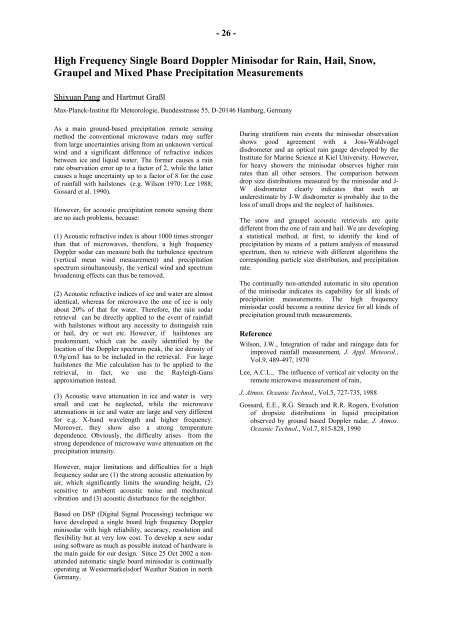Fourth Study Conference on BALTEX Scala Cinema Gudhjem
Fourth Study Conference on BALTEX Scala Cinema Gudhjem
Fourth Study Conference on BALTEX Scala Cinema Gudhjem
You also want an ePaper? Increase the reach of your titles
YUMPU automatically turns print PDFs into web optimized ePapers that Google loves.
- 26 -<br />
High Frequency Single Board Doppler Minisodar for Rain, Hail, Snow,<br />
Graupel and Mixed Phase Precipitati<strong>on</strong> Measurements<br />
Shixuan Pang and Hartmut Graßl<br />
Max-Planck-Institut für Meteorologie, Bundesstrasse 55, D-20146 Hamburg, Germany<br />
As a main ground-based precipitati<strong>on</strong> remote sensing<br />
method the c<strong>on</strong>venti<strong>on</strong>al microwave radars may suffer<br />
from large uncertainties arising from an unknown vertical<br />
wind and a significant difference of refractive indices<br />
between ice and liquid water. The former causes a rain<br />
rate observati<strong>on</strong> error up to a factor of 2, while the latter<br />
causes a huge uncertainty up to a factor of 8 for the case<br />
of rainfall with hailst<strong>on</strong>es (e.g. Wils<strong>on</strong> 1970: Lee 1988;<br />
Gossard et al. 1990).<br />
However, for acoustic precipitati<strong>on</strong> remote sensing there<br />
are no such problems, because:<br />
(1) Acoustic refractive index is about 1000 times str<strong>on</strong>ger<br />
than that of microwaves, therefore, a high frequency<br />
Doppler sodar can measure both the turbulence spectrum<br />
(vertical mean wind measurement) and precipitati<strong>on</strong><br />
spectrum simultaneously, the vertical wind and spectrum<br />
broadening effects can thus be removed.<br />
(2) Acoustic refractive indices of ice and water are almost<br />
identical, whereas for microwave the <strong>on</strong>e of ice is <strong>on</strong>ly<br />
about 20% of that for water. Therefore, the rain sodar<br />
retrieval can be directly applied to the event of rainfall<br />
with hailst<strong>on</strong>es without any necessity to distinguish rain<br />
or hail, dry or wet etc. However, if hailst<strong>on</strong>es are<br />
predominant, which can be easily identified by the<br />
locati<strong>on</strong> of the Doppler spectrum peak, the ice density of<br />
0.9g/cm3 has to be included in the retrieval. For large<br />
hailst<strong>on</strong>es the Mie calculati<strong>on</strong> has to be applied to the<br />
retrieval, in fact, we use the Rayleigh-Gans<br />
approximati<strong>on</strong> instead.<br />
(3) Acoustic wave attenuati<strong>on</strong> in ice and water is very<br />
small and can be neglected, while the microwave<br />
attenuati<strong>on</strong>s in ice and water are large and very different<br />
for e.g. X-band wavelength and higher frequency.<br />
Moreover, they show also a str<strong>on</strong>g temperature<br />
dependence. Obviously, the difficulty arises from the<br />
str<strong>on</strong>g dependence of microwave wave attenuati<strong>on</strong> <strong>on</strong> the<br />
precipitati<strong>on</strong> intensity.<br />
However, major limitati<strong>on</strong>s and difficulties for a high<br />
frequency sodar are (1) the str<strong>on</strong>g acoustic attenuati<strong>on</strong> by<br />
air, which significantly limits the sounding height, (2)<br />
sensitive to ambient acoustic noise and mechanical<br />
vibrati<strong>on</strong> and (3) acoustic disturbance for the neighbor.<br />
Based <strong>on</strong> DSP (Digital Signal Processing) technique we<br />
have developed a single board high frequency Doppler<br />
minisodar with high reliability, accuracy, resoluti<strong>on</strong> and<br />
flexibility but at very low cost. To develop a new sodar<br />
using software as much as possible instead of hardware is<br />
the main guide for our design. Since 25 Oct 2002 a n<strong>on</strong>attended<br />
automatic single board minisodar is c<strong>on</strong>tinually<br />
operating at Westermarkelsdorf Weather Stati<strong>on</strong> in north<br />
Germany.<br />
During stratiform rain events the minisodar observati<strong>on</strong><br />
shows good agreement with a Joss-Waldvogel<br />
disdrometer and an optical rain gauge developed by the<br />
Institute for Marine Science at Kiel University. However,<br />
for heavy showers the minisodar observes higher rain<br />
rates than all other sensors. The comparis<strong>on</strong> between<br />
drop size distributi<strong>on</strong>s measured by the minisodar and J-<br />
W disdrometer clearly indicates that such an<br />
underestimate by J-W disdrometer is probably due to the<br />
loss of small drops and the neglect of hailst<strong>on</strong>es.<br />
The snow and graupel acoustic retrievals are quite<br />
different from the <strong>on</strong>e of rain and hail. We are developing<br />
a statistical method, at first, to identify the kind of<br />
precipitati<strong>on</strong> by means of a pattern analysis of measured<br />
spectrum, then to retrieve with different algorithms the<br />
corresp<strong>on</strong>ding particle size distributi<strong>on</strong>, and precipitati<strong>on</strong><br />
rate.<br />
The c<strong>on</strong>tinually n<strong>on</strong>-attended automatic in situ operati<strong>on</strong><br />
of the minisodar indicates its capability for all kinds of<br />
precipitati<strong>on</strong> measurements. The high frequency<br />
minisodar could become a routine device for all kinds of<br />
precipitati<strong>on</strong> ground truth measurements.<br />
Reference<br />
Wils<strong>on</strong>, J.W., Integrati<strong>on</strong> of radar and raingage data for<br />
improved rainfall measurement, J. Appl. Meteorol.,<br />
Vol.9, 489-497, 1970<br />
Lee, A.C.L., The influence of vertical air velocity <strong>on</strong> the<br />
remote microwave measurement of rain,<br />
J. Atmos. Oceanic Technol., Vol.5, 727-735, 1988<br />
Gossard, E.E., R.G. Strauch and R.R. Rogers, Evoluti<strong>on</strong><br />
of dropsize distributi<strong>on</strong>s in liquid precipitati<strong>on</strong><br />
observed by ground based Doppler radar, J. Atmos.<br />
Oceanic Technol., Vol.7, 815-828, 1990













